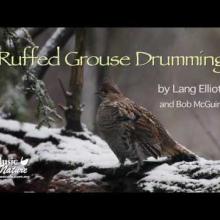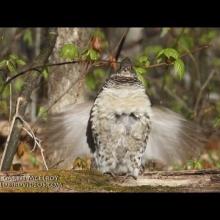

Join BirdNote tomorrow, November 30th!
Illustrator David Sibley and actor H. Jon Benjamin will face off in the bird illustration battle of the century during BirdNote's Year-end Celebration and Auction!
The world is full of poisonous creatures. Some butterflies, beetles and frogs use bright colors to warn birds and other predators that they’re full of toxins. But you might be surprised to learn that some birds are poisonous, too. Birds called Hooded Pitohuis carry toxins produced by a beetle that they eat, Ruffed Grouse can pick up a poison from a plant called mountain laurel, and Common Quail sometimes snack on poisonous hemlock.
BirdNote®
Poisonous Birds
Written by Conor Gearin
This is BirdNote.
The world is full of poisonous creatures. Some butterflies, beetles and frogs use bright colors to warn birds and other predators that they’re full of toxins. But you might be surprised to learn that some birds are poisonous, too.
[Hooded Pitohui song]
The Hooded Pitohui is a bird that lives in New Guinea and eats a toxic beetle. The pitohuis aren’t sensitive to the beetle’s toxin, so they can accumulate large amounts of it in their skin and feathers.
Scientists examined the chemicals from pitohui feathers and identified the same type of toxin found in poison-dart frogs. Like the birds, the frogs may also gain their chemical defenses from eating insects.
But pitohuis aren’t the only birds that pack a toxic punch. When Ruffed Grouse eat a plant called mountain laurel, they pick up a poisonous compound that can make them an unappetizing meal for a fox or a human hunter.
[Ruffed Grouse calls]
And quail in the Eastern Hemisphere sometimes snack on hemlock, turning them into a very upsetting dinner item.
[Common Quail calls]
Many predators like to eat birds, making the world a pretty dangerous place for them. But evolution has made some birds a little dangerous, too.
[Hooded Pitohui song]
For BirdNote, I’m Michael Stein.
###
Senior Producer: Mark Bramhill
Producer: Sam Johnson
Managing Editor: Jazzi Johnson
Content Director: Jonese Franklin
Bird sounds provided by The Macaulay Library of Natural Sounds at the Cornell Lab of Ornithology, Ithaca, New York. Ruffed Grouse ML 446222541 recorded by Andrew Spencer, and Common Quail ML 354955891 recorded by Hans Norelius.
Hooded Pitohui Xeno Canto 750410 recorded by Iain Woxvold.
BirdNote’s theme was composed and played by Nancy Rumbel and John Kessler.
© 2023 BirdNote March 2023/2025
Narrator: Michael Stein
ID# poison-01-2023-03-14 poison-01
Reference:
https://pubmed.ncbi.nlm.nih.gov/25839151/
https://repository.si.edu/bitstream/handle/10088/4037/Dumbacher1992.pdf…;
https://www.mcgill.ca/oss/article/did-you-know/pitohui-bird-contains-de…
https://link.springer.com/article/10.1007/s13181-022-00891-6





